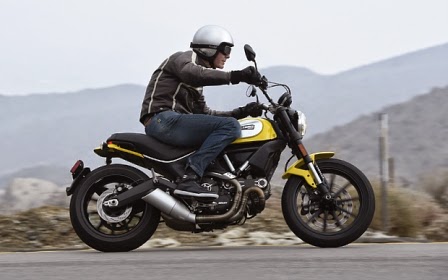The Ducati Scrambler is a motorcycle that is absolutely of its time. Created as an entry-level roadster in an attempt to attract new and younger riders to the iconic Italian brand, it's essentially a simple, 803cc air-cooled V-twin with styling inspired by the firm's single-cylinder Scrambler models of the Seventies.
But there's nothing remotely simple about Ducati's unprecedented promotional campaign, which has involved a barrage of social media and videos; workers being given sneak previews of the Scrambler in a large yellow crate at a fake beach set up outside the factory in Bologna factory; and the creation of an irony-free "Land of Joy" in which the bike has been displayed at major shows and the press riding launch in California.
"It's not Ducati, it's Scrambler," is the official line, the thinking being that Ducatis are powerful and high-tech, while the Scrambler was created to be contrastingly down-to-earth. Even so, this was a complex project. The range of accessories and clothing, double the normal amount for a new bike, includes checked shirts and open-face helmets to reinforce the carefully cultivated Seventies image. And the Scrambler follows modern patterns by being produced in Ducati's factories in Brazil and Thailand, as well as in Bologna.
It also takes two-wheeled platform engineering to a new level by being launched as four distinct models. All use the same engine, tubular steel frame and most cycle parts. While the base-model Scrambler Icon is a roadster with yellow or red paintwork, the Classic has a more obviously retro look, in orange with a brown seat and wire-spoked wheels; the Full Throttle is sportier, with lower handlebar, humped seat and Termignoni silencer; and the Urban Enduro matches green finish with a headlamp grille, engine bash-plate and other off-road styling cues.
The shared engine is a detuned version of the sohc, 90-degree desmo unit from the discontinued Monster 796, its maximum output reduced from 87 to 75bhp by changes including new camshafts and exhaust system. Unlike other recent Ducatis it has no ride-by-wire fuelling, alternative power modes or traction control; just a pleasingly broad power delivery that helps make the Scrambler both quick and easy to ride.
All the bikes on the launch were the base-model Icon, which has a very upright riding position dictated largely by its wide, upswept one-piece handlebar. Despite this, it feels quite sporty thanks to its relatively light weight (just 186kg with fuel), fairly rearset footrests and a slim, though well-padded, seat that is low enough to allow most riders to put both feet flat on the ground.
Straight-line performance is enjoyably brisk, the engine happy to pull strongly from almost any revs, which is useful because the round instrument panel features a large central digital speedometer but a slim and less than legible rev-counter bar running around its lower circumference. The minimalist, alloy-rimmed console is attractive but also lacks a fuel gauge or gear indicator.
Throttle response is crisp; slightly sharp on initial opening in the lower gears, but not enough to annoy or hinder control. The Ducati cruised effortlessly and smoothly at the legal limit, well short of its top speed of about 130mph. I found the six-speed gearbox both light and precise, although some riders reported a slightly harsh change that might improve with more use.
The chassis is well matched to the engine, giving easy and confidence-inspiring handling. There is minimal potential for suspension adjustment; just preload of the diagonally mounted rear shock. Both ends are quite firm by roadster standards, but ride quality is reasonably good, and the result is a bike that is fun to flick through a set of bends, the wide handlebar helping it to change direction with little effort. Stopping power is very reassuring, too, due largely to the big, ABS-equipped single front disc and its four-piston Brembo radial caliper.
The Scrambler is not designed for practicality, having a fairly small, 13.5-litre tank that will give a range of about 120 miles. But it has a useful USB socket and phone storage area under the seat, and the array of accessories includes luggage as well as alternative tank panels to customise the look. Extras will inevitably add to the cost but the Scrambler is keenly priced by Ducati standards, costing £6,995 for the yellow Icon tested, £100 less for the same bike in red, or £7,995 for the other three versions.
It's possible that in years to come this first Scrambler will be remembered less for its relatively modest performance than for its state-of-the-art marketing campaign, which appears to be working. Ducati UK reports more than 200 orders already, suggesting that the Scrambler is likely to be the firm's best selling model this year. So it's good to be able to conclude that when you strip away the Land of Joy and the social media storm, what's left is an enjoyably simple, quick and rider-friendly motorbike.
THE RIVALS:
Harley-Davidson Sportster Iron 883, from £7,145
Harley’s base-model V-twin has heaps of cool, but is heavy and softly tuned, so for a performance match with the Scrambler you’d need the pricier 1,200cc Sportster.
Moto Guzzi V7 Stone II, from £6,934
You get plenty of Italian V-twin retro style with Guzzi’s recently updated 744cc roadster, but the softly tuned Stone makes just 48bhp so can’t match the Scrambler’s lively performance.
Triumph Scrambler, from £7,699
The name’s the same but Triumph’s 865cc, 59bhp parallel twin Scrambler is very different: bigger, softer and more comfortable, but lacking the lighter Ducati’s acceleration and agility.
Source : telegraph[dot]co[dot]uk




No comments:
Post a Comment